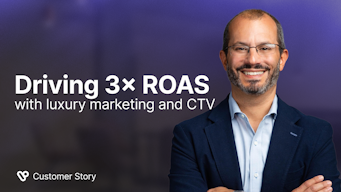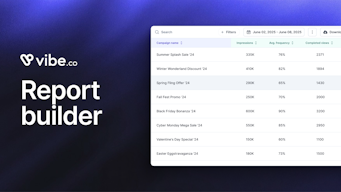What is OTT advertising and how does it work? A comprehensive guide
This article explains in detail what OTT advertising is and how it works as well as why it’s relevant for marketers today.
What is OTT advertising?
OTT advertising is a specific form of online video advertising, that has emerged with the development of a wide range of new streaming services.
But before we get into OTT advertising, let’s answer the question, what is OTT streaming? OTT stands for “over-the-top” and refers to the delivery of TV and movie content via the internet, or by going “over the top” of regular broadcast or cable television.
As long as there’s an internet connection, OTT provides access to content anytime, anywhere, on any device (i.e., smart TVs, mobile phones, tablets, computers, gaming consoles, Chromecast, Amazon Fire Stick, Roku) and on any streaming service or network (like Netflix, Amazon Prime). Consumers appreciate streaming OTT services for its delivery of high-value content and its low costs, its original content, and its compatibility with multiple devices.
Not all OTT services or OTT apps are the same, and here are several terms you should know:
- SVOD (subscription video on demand): these streaming services require a subscription (Netflix, Hulu, & Amazon Prime Video)
- AVOD (advertising-based video on demand): these streaming services provide free, ad-supported streaming video (Crackle, Tubi, Vudu)
- vMVPDs (multichannel video programming distributors): these streaming service providers work via paid-TV programming (AT&T Now, Sling, YouTube TV)
- CTV (connected TV): this refers to a TV device that is connected to the internet (distinct from OTT but can work via OTT)
- Linear TV: this is traditional TV, with scheduled broadcasts (not OTT)
So what is OTT advertising? OTT advertising is promotional content streamed via the above mentioned OTT channels.
Read more: What is the difference between CTV, OTT and Linear TV?
How does OTT advertising work?
The most popular type of OTT service is video OTT, with OTT platforms like Netflix, Hulu or Disney+ or HotStar that offer a variety of programming options. Audio, messaging and voice services (think: Spotify, Whatsapp, or Skype) are also present in the OTT space.
OTT services either operate on a paid subscription basis or through a tiered model, with packages that allow users to pay for ad-free experiences, or through free packages with ads. As such, OTT advertising works like traditional media ads, between episodes or songs, for example, but it’s delivered via the internet on OTT platforms or apps.
In terms of OTT ad delivery, there are two main possibilities. The client-side setup loads the ad before the episode or film is shown, while in the server-side ad setup, the ad is integrated into the frames of the media itself, with no potential for ad-blocking. The latter is more technically challenging to deliver, so it remains less common.
When it comes to buying OTT ads, the choice is generally between Guaranteed IOs (insertion orders) and Programmatic. The former have set prices and set impressions, generally based on frequency and overall reach. The latter option utilizes a real-time bidding environment that allows the advertiser to control targeting, but it does not guarantee frequency or impressions.
Why use OTT advertising as marketers?
A relatively new phenomenon, OTT holds a lot of potential and promise for marketing. OTT advertising may even be reshaping the paid media landscape as we know it. As more OTT providers and platforms enter the space, consumers have more and more options, and marketers have access to increasing quantities of ad inventory. Ultimately, as more users move towards OTT media consumption, targeting them via OTT ads becomes increasingly relevant. As an illustration of the potential reach of OTT media, over 50% of people in North America— that’s 1 in 2 people—have Netflix subscriptions. Another US-based survey showed that 70% of respondents aged 18 to 34 years old claimed to currently subscribe to a streaming service.
OTT is an important channel for marketing and sales initiatives, thanks to the potential it provides in terms of scaling, measuring, and data-driven targeting. Thanks to these capabilities, OTT video provides not only upper-funnel awareness, but it can also help build your brand, engage customers and move them through an entire funnel.
OTT video is especially important for two types of strategies:
- TV advertisers who want to recapture their reach
- Challenger brands that don’t have budget for direct broadcast, but who are looking to broaden their marketing strategy.
Read more: CTV: The Gaming Marketer’s New Secret Weapon
Amidst growing data privacy concerns and privacy-led industry changes, OTT advertising is emerging as an attractive advertising option for several reasons. First of all, TVs never had cookies or related privacy issues. Secondly, when consumers purchase or set up a new streaming service or device, they generally agree to participate in data-driven marketing and to accept the provider’s privacy policy. In this way, OTT is considered an opt-in compliant channel by nature.
Create your first OTT campaign
The advantages of OTT advertising over broadcast television
OTT ad content has several advantages over traditional broadcast or cable television.
- Custom audience: OTT ads allow advertisers to build a specific, custom audience based on certain demographics, and therefore to target their ideal customers.
- Guaranteed viewership: OTT viewers cannot skip ads or change the channel, which means the OTT advertisers have the advantage of a guaranteed audience.
- Geographic specificity: Thanks to the nature of the delivery of OTT services, advertisers on these platforms can get more specific (down to the zipcode!) with geographic targeting as compared to broadcast or cable TV.
- Advanced analytics: As OTT content is delivered and consumed via the internet, you can get detailed and advanced analytics about your ad performance, and then tweak and optimize digital ads to better engage with your target audience.
- High-quality impressions: Because of the better targeting made possible by OTT services, you’ll get more impressions, and they will be of higher quality.
The types of content suitable for OTT advertising
As video content is the most popular type of OTT services, thanks to platforms like Netflix (subscription model); iTunes (paid storefront); and YouTube (ad-based), OTT video is a prime choice for video ad placement. Audio streaming services, like Spotify or other radio and podcast platforms are another sensible choice for OTT advertising. Depending on the platform, either video or audio ads would be appropriate. You may consider a cross-channel OTT strategy, so you can reach your audience across OTT, audio, display and more.
When it comes to publishing OTT video ads, marketers can work with several OTT distribution channels: TV publishers, OTT native services, streaming linear services, or OTT devices. Roku, Hulu and Sling TV are among the more popular OTT channels or streaming devices.
What are some OTT advertising best practices?
Think about your OTT ads as targeted ad experiences for a more advanced audience. Some best practices include:
- Ensuring that your video ads are formatted for multiple devices, whether a mobile phone or a large TV screen. The value proposition and CTA (call to action) should be clear at any scale.
- Keeping it short, ideally 30 seconds or less (for non skippable-ads), is ideal. OTT users have certain expectations for streaming content.
- Delivering dynamic content that is relevant and personalized to your targeted audience. Consider all kinds of behavior and demographic signals when planning your OTT video ads.


